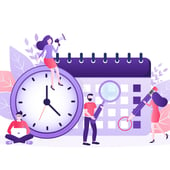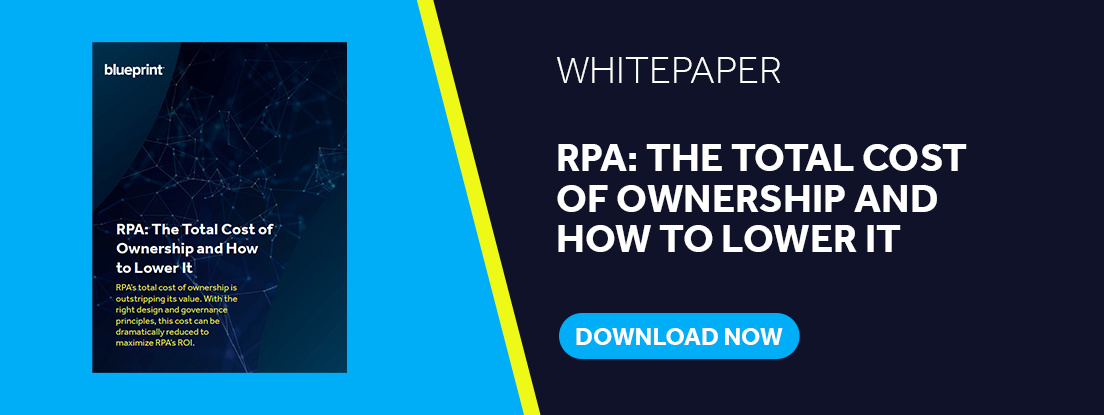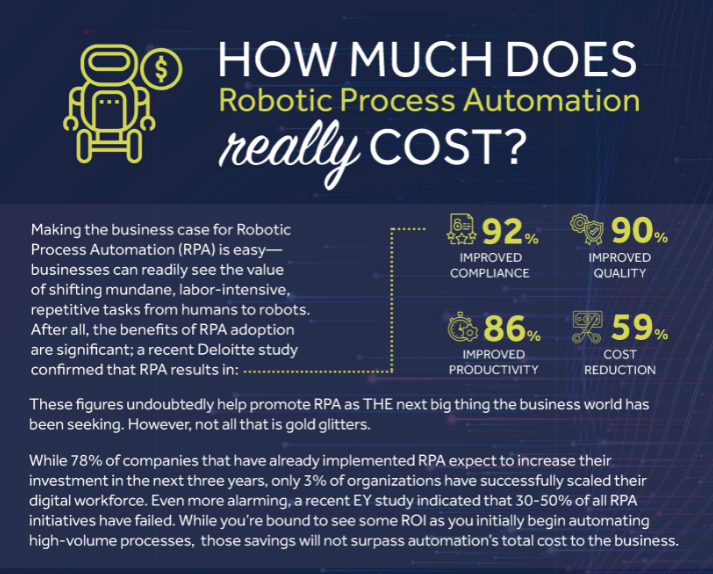5 Things To Consider if You Want to Lower RPA's Total Cost of Ownership
Imagine this: a bot that's up and running in just weeks, costs a fraction of a salary, works around the clock, and hardly ever makes a mistake. That's RPA, and it's taken the business world by storm. But, before you jump in with both feet, throw all your eggs in the RPA basket, and the baby out with the bathwater, stop, drop, and consider the total cost of ownership (TCO) of RPA.
Calculating the TCO of an RPA implementation is crucial for organizations to get a clear picture of how RPA adoption will impact profitability over time and ensure they select the right tool(s) to meet their automation needs. Hardware and software are the foundation of TCO; however, these are but the initial investment costs of RPA.
To guarantee a well-informed decision, RPA buyers must consider the ongoing costs of ownership beyond implementation and where opportunities might exist for lowering costs.
1. Choose the right processes for automation
One of the biggest (and costliest) challenges businesses face in their RPA implementations is choosing the right processes for automation. Imagine the waste of resources and time if RPA is used to automate processes that do not add value to the business.
Nearly 1/3 of unsuccessful automation projects can be attributed to poor process selection. To ensure that you're choosing the right processes to be automated, a simple framework that aligns the intent of RPA with the organization's strategic objectives should be created.
Your framework should look at both the potential risks and the expected value driven by a particular function's automation.
We know that automation promises significant cost, quality and speed improvements, but realizing those benefits requires action plans. A successful RPA initiative is built on a sound automation strategy.
RPA may be the technological equivalent of the goose that laid golden eggs, but to continue laying, one has to care and tend to it. Much like in the fable, short-sighted action in pursuit of quick gains can quickly destroy an asset's profitability.
2. The hidden costs of maintenance and support
 There is no questioning the value enterprises see in automation. But the returns and quick time-to-value promised by RPA vendors haven't been so forthcoming. Instead, enterprises across industries spend the bulk of their time and resources patching up brittle digital workforces that easily break, keeping returns low and frustrations high.
There is no questioning the value enterprises see in automation. But the returns and quick time-to-value promised by RPA vendors haven't been so forthcoming. Instead, enterprises across industries spend the bulk of their time and resources patching up brittle digital workforces that easily break, keeping returns low and frustrations high.
One glaring issue with RPA maintenance and support is that it's mostly reactionary. Maintenance of RPA happens when a bot has produced an error, and automation teams scramble to minimize downtime.
Yet, the diagnostic work necessary to understand where and why the error occurred, followed by taking the corrective actions needed to fix the bot are usually big time-sucks that do little to limit bot downtime.
The key is to transition from reactive RPA management to a proactive strategy with the right design principles. Many maintenance issues and outages are avoidable if you take a comprehensive approach to designing automations and communicating the entire context with precise guidelines to your developers.
Learn more: How to Reduce the Rising Costs of RPA Maintenance and Support
3. Software
 Most RPA vendors sell their software in the form of 'bot' licenses. Typically, they require a minimum commitment in terms of the number of 'bots' and the license duration—meaning that right from the get-go, you may be committing to a higher bot capacity than your RPA program requires.
Most RPA vendors sell their software in the form of 'bot' licenses. Typically, they require a minimum commitment in terms of the number of 'bots' and the license duration—meaning that right from the get-go, you may be committing to a higher bot capacity than your RPA program requires.
There are more flexible software licensing models available, such as consumption or transactional licensing, that make getting your RPA implementation (however small it may be) off the ground much more fiscally manageable.
It’s important to note that once you scale your solution, costs will inevitably go up. Each model has pros and cons, but the key takeaway is that having a strategic direction for your automation program in place ensures that you're not leaving money on the table due to under-utilization.
4. Resources
 RPA vendors often claim they enable the 'citizen developer' and that their tools can be deployed with no special skills. We've learned, however, that this is simply not true. Implementing RPA, like with any enterprise technology, requires input from Developers, Project Managers, Business Analysts, and IT staff.
RPA vendors often claim they enable the 'citizen developer' and that their tools can be deployed with no special skills. We've learned, however, that this is simply not true. Implementing RPA, like with any enterprise technology, requires input from Developers, Project Managers, Business Analysts, and IT staff.
You may already have the necessary resources on staff, but by reallocating responsibilities, you may create new gaps that need filling. Alternatively, your RPA program may create a need for new roles, like change management experts or operational resources for your RPA Center of Excellence (CoE).
Even the smallest automation CoE will typically require five unique positions to function effectively, so building your in-house team can quickly escalate into a high operational cost.
Alternatively, you may decide to work with a consulting or professional services firm for your RPA implementation, but this option comes with its own associated costs.
5. Pricing organizational change
 When implementing any new technology, the costs that first come to mind are the following one-time expenses:
When implementing any new technology, the costs that first come to mind are the following one-time expenses:
- licensing
- hardware/software infrastructure
- proof of concept (PoC)
- development and configuration
There are, however, several ongoing costs that should also be considered to ensure you have a fulsome understanding of your total cost of ownership. These costs include:
- infrastructure and architecture maintenance
- third-party integrations (like process/task mining software) that enable your automation program
- yearly RPA license renewal fees
- training and/or hiring for internal SMEs
- third-party integrations and renewals (cost of complementary software like process mining, process discovery, etc.)
- change management programs
- costly break-fix cycles that limit RPAs true potential
Understanding the potential cost implications of these items will ensure your expectations are both realistic and achievable. After all, RPA can drive significant value, but it is not a turnkey solution.
Without the right strategy and complementary tools, your RPA implementation can quickly get caught in costs that keep it from delivering on expected ROI. When considering RPA for your organization, you must also consider the following:
- Robots are only as good as they're programmed to be; the right upfront design can significantly reduce RPA maintenance and support.
- Maximizing the impact of your RPA investment requires a commitment to cross-functional teamwork. Impactful process improvement demands the centralized, collaborative effort of your organization's business and IT functions.
- Process improvement/optimization and process automation go hand in hand. Optimizing a business process before automating it is one of the keys to successfully implementing automation at scale.
Ultimately the key to RPA success is understanding that it’s not a silver bullet. Instead, RPA is a cog in the wheel of your business that, when appropriately oiled, can turn far more efficiently.
Read our whitepaper and discover how Blueprint can reduce your RPA total cost of ownership while maximizing ROI.
Share this
Recent Stories

How to Reduce the Rising Costs of RPA Maintenance and Support

INFOGRAPHIC: How much does Robotic Process Automation (RPA) Really Cost?

